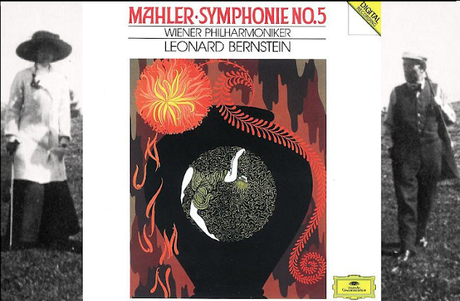
A triptych: Alma and Gustav Mahler (left and right, the original is one photograph.) Center: the album art by Erte,
© 1987 Deutsche Grammophon Gesellschaft/UMG
Let us take a moment to introduce the Vienna Philharmonic. That orchestra, founded as a private organization in 1842 and still going strong today, has no music director. (From the years of 1897-1907, Mahler conducted many performance at the Vienna Court Opera and at the Musikverein, and introduced many controversial reforms.) All decisions of programming, the invitation of conductors and scheduling are made by the musicians themselves. All members must first play for three years in what is now the the Vienna State Opera orchestra (then the Wiener Hofoper) before they may audition for the the Philharmonic.
Like the Second Symphony before it, the Fifth starts with a massive funeral march. Bernstein takes this Trauermarsch a bit slower and longer than many other conductors, setting a leaden pace that adds to the music's weight and grief. A ringing trumpet theme (the same one heard briefly in the first movement of the Fourth Symphony) starts the cortége, which lumbers forward in majestic and relentless fashion. The steady tread is interrupted by explosions of orchestral rage, cries de couer that add to the weighty chest-beating going on. It ends with a single, muffled thump, eloquently described by Carnegie Hall program note annotator Jack Sullivan as "the close of a coffin lid."
The second movement is a sort of counterbalance to the first,embroidering further on the same musical material. This movement, marked "Sturmisch Bewegt, Mit Grosster Vehemenz" ("Stormy and lively, with great vehemence") seems to have trouble deciding whether it is an allegro or a scherzo, veering between musical ideas including the main subject of the movement that came before. It is the first of several such puzzle-box movements in Mahler's middle period, and yet it ends in a burst of redemptive major-key light, an indication of where this symphony is ultimately headed.
To this day, musicians of the Vienna Philharmonic adhere the same instruments as at the orchestra's founding. This unique Vienna sound is best heard in the opening of the third movement, where the "Viennese" horn in F leads off the scherzo with a brief, three-note solo. Although narrower in bore than the standard orchestral double horn (and more difficult to play well) the F horn with its unique pumpenvalve mechanism produces a smoother tone with better legato between notes. It is also, according to non-Austrian horn players, a more difficult instrument to master, partially because the mouthpiece is a narrower cone.
The Vienna horns dominate the third movement of this performance. Theirs is a full range of expression, from gentle lament to full exultation. Mahler made this movement the linch-pin of this symphony, transiting from the darkness of the first movements to the radiance hinted at at the end of the second. He does so with a series of dances, some of them lilting like a Viennese dance orchestra, others plucked by the strings at a slow, almost tentative effect. At the movement's end, the exultant horns bring it all back home to triumphant major key, pointing the way forward to the optimistic ending of the work.
In 1902, Mahler married Alma Schindler, a composer, songwriter and socialite in Vienna that he had met the year before. (At that time she was the mistress of composer Alexander von Zemlinsky.) Alma was a talent in her own right, and the only tragedy of her marriage to Gustav was that she forewent composition in order to have his children. Mahler fell in love with Alma, and the Adagietto of this symphony is his strings-and-harp expression of that love. Bernstein, perfectly aware that this movement is the most famous movement in the Mahler canon, milks it here for every last drop of emotion, often leaning back and letting the strings lead with the slow-rolling melody.
The opening of the final Rondo takes Mahler's sound (briefly) back to the bird-songs and innocent wilderness wandering that started his Symphony No. 1. Except here there is a sense that the journey is that of a sadder and wiser hero who has been to both ends of the cosmos in a quest for truth and has found it at last in the haven of pure musical thought. There is no voice of a child or chorus ringing bells: just the Viennese players engaging in the most complex counterpoint that Mahler had written up to that point. References to the first four movements and indeed the four symphonies that came before pepper the landscape, familiar ideas re-presented with the new wisdom gained of hard experience. This is Bernstein and the Vienna players at their most exuberant, a complete turn from the darkness in which this symphony began.

